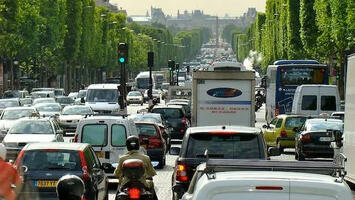
One of the arguments against single-family zoning is that separating housing from other uses forces people to drive to shops, work, and other destinations. Urban planners want to redesign cities so that people can walk to most of those destinations. They even have a name for it: the 15-minute city, meaning everyone can reach all of their primary destinations within a 15-minute walk.
In a paper published in January, urban analyst Alain Bertaud has demolished this goal. Noting that Paris Mayor Anne Hidalgo made this goal a part of her re-election campaign in 2020 and continues to promote it in office, he looked at the city to see what would need to be done to meet this goal.
Bertaud starts out by calculating that a person can reach about 740 acres in a 15-minute walk on city streets. Based on the average population of the municipality of Paris (as opposed to the urban area), an average of 77,000 people live in any given 740 acres of land. Within this 740 acres, there are an average of 59 bakeries and 197 food stores. There are also enough elementary schools to be within 15 minutes of every part of the city. Thus, there is no need to “create” a 15-minute city; Paris already is one.
So why, then does anyone drive in Paris? Bertaud notes that Paris has 1.6 jobs for every worker, with more than 51,000 jobs within a 15-minute walk of typical residents. Yet lots of people drive to work and more than half the workers take more than 30 minutes to get to work. Only 12 percent take 15 minutes or less.
The problem, of course, is there may be 51,000 jobs within walking distance of your home, but that doesn’t mean that your job is within a 15-minute walk from your home. Commuting makes up less than 20 percent of trips in the United States, and it is probably similar in France. That means, when people decide where to live, their work location isn’t necessarily the controlling factor.
No doubt the same logic applies to other possible destinations. I grew up within a 15-minute walk of one of Portland’s most prestigious high schools, but I decided to go to a different school that was a one-hour bus ride away. There might be 197 food stores within 15 minutes of where I live, but they might also be expensive and I’d prefer to save money by shopping at a hypermarket that is several miles away.
Bertaud fears that, when cities achieve the dream of putting everything within 15 minutes of every resident and these residents continue driving anyway, the cities will impose more draconian regulation to try to reduce driving. The mayor of Paris, for example, wants to make it illegal to drive through central Paris. France has also forbidden large booksellers from selling books at a discount so as to preserve the viability of small bookshops within walking distance of everyone’s homes.
Considering the kind of regulations we already have in the United States — such as the Oregon rule forbidding landowners in most rural areas from building a house on their own property unless they own at least 80 acres, actively farm it, and earned $80,000 a year from farming it in two of the last three years — it isn’t hard to imagine similar kinds of rules being imposed here.
Even if Paris already is a 15-minute city, the 15-minute policy would be a lot harder to implement in American cities. Other than Manhattan, no city in America has Paris-like densities of more than 66,000 per square mile. American urban densities averaged under 2,400 per square mile in 2010. That’s not dense enough to put all the services people need within a 15-minute walk.
For example, the nation has about 38,000 supermarkets, nearly all of which are located in the 105,000 square miles of urban areas. That about 2.75 square miles per supermarket, which is about 1,760 acres, more than twice the amount of land within a 15-minute walk. Thus, even if supermarkets were perfectly evenly distributed across the urban landscape, more than half the people wouldn’t be within 15 minutes of one of them. That’s one reason why planners have such a mania for increasing urban densities.
We’re not going to double urban densities, especially when the doing so will fail to eliminate driving anyway. As urban economist Edward Glaeser once wrote (as quoted in Bertaud’s paper), the 15-minute city “should be recognized as a dead-end which would stop cities from fulfilling their true role as engines of opportunity.”
This piece first appeared at Frontier Centre for Public Policy.
Randal O'Toole, the Antiplanner, is a policy analyst with nearly 50 years of experience reviewing transportation and land-use plans and the author of The Best-Laid Plans: How Government Planning Harms Your Quality of Life, Your Pocketbook, and Your Future.
Photo: Dr. Bob Hall via Flickr under CC 2.0 License












